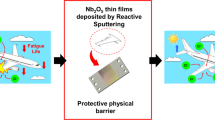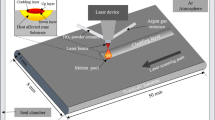Abstract
Conclusions Powdered A12O3—TiO2 of the highest quality, characterized by a high degree of purity and homogeneity, are obtained by the method of crystallizing melts in a cold crucible. Detonation coatings from such powders have a uniform structure, uniform phase composition, and they have a complex of good physicomechanical properties: density, great separating strength of the substrate, mechanical strength. An addition of TiO2 to powdered aluminum oxide stabilizes the crystal lattice of the phase α-Al2O3 which is decisive for the heat and wear resistance of coatings. Moreover, an addition of TiO2 increases the interparticular bond in the coating and its adhesive strength with the substrate. It is indispensable to point out the selectivity of the properties of detonation coatings type AT-40 in regard to the surfaces of the protected metals. The greatest strength of adheion with the coatings is found in chromium and titanium substrates; in steel, brass, and aluminum ones the strength is somewhat lower. The high selectivity of the properties is most probably due to the difference in sublimation energy and melting points of the materials of the substrate, their hardness and brittleness. It was noted that the adhesive bond between aluminum titanate coatings and the substrates is anomalously strong; this is due to the uniqueness of its properties. Coatings and substrates have a mutual effect on the strength and plastic properties. As a rule, coatings lower the bending strength of the substrate. An exception are chromium alloys which only become embrittled without loss of strength, and substrates of ductile low alloy steels which are somewhat strengthened by coatings.
Similar content being viewed by others
Literature cited
C. Hermann, “Amperit-powders for thermal and plasma spraying,” Berlin Stark Techn. Bull., No. 5, 14 (1973).
S. Safai and X. Herman, “Plasma sprayed coatings; their ultramicrostructure,” Adv. Surf. Coat. Technol., No. 3, 1–14 (1978).
F. I. Dittrich, Patent 3322515 (USA), Flame Spraying Exothermally Reacting Intermetallic Compound Forming Composites, Published May 30, 1967.
Yu. G. Tkachenko,A. P. Garda, D. Z. Yurchenko,et al., “Wear-resistant detonation oxide coatings,” Poroshk. Metall., No. 6, 59–62 (1977).
Yu. B. Petrov and D. G. Ratnikov,Cold Crucibles [in Russian],-Metallurgiya,Moscow (1972).
D. N. Poluboyarinov,V. L. Balkevich, and R. Ya. Popil'skii,High Aluminous Ceramic and Refractory Materials [in Russian],Gosstroiizdat,Moscow (1960).
N. A. Toropov and V. P. Barzakovskii,Phase Diagrams of Silicate Systems (Handbook), Issue 1: Binary Systems [in Russian],Nauka,Leningrad (1969).
M. A. Maurakh and B. S. Mintin,Liquid High Melting Oxides [in Russian],Metallurgiya,Moscow (1979).
Author information
Authors and Affiliations
Additional information
Translated from Poroshkovaya Metallurgiya, No. 5(281), pp. 59–64, May, 1986.
Rights and permissions
About this article
Cite this article
Fedorenko, V.K., Tkachenko, V.D., Ivashchenko, R.K. et al. Structural and phase characteristics and physicomechanical properties of detonation coatings in the system aluminum oxide-titanium oxide. Powder Metall Met Ceram 25, 405–410 (1986). https://doi.org/10.1007/BF00813956
Received:
Issue Date:
DOI: https://doi.org/10.1007/BF00813956




